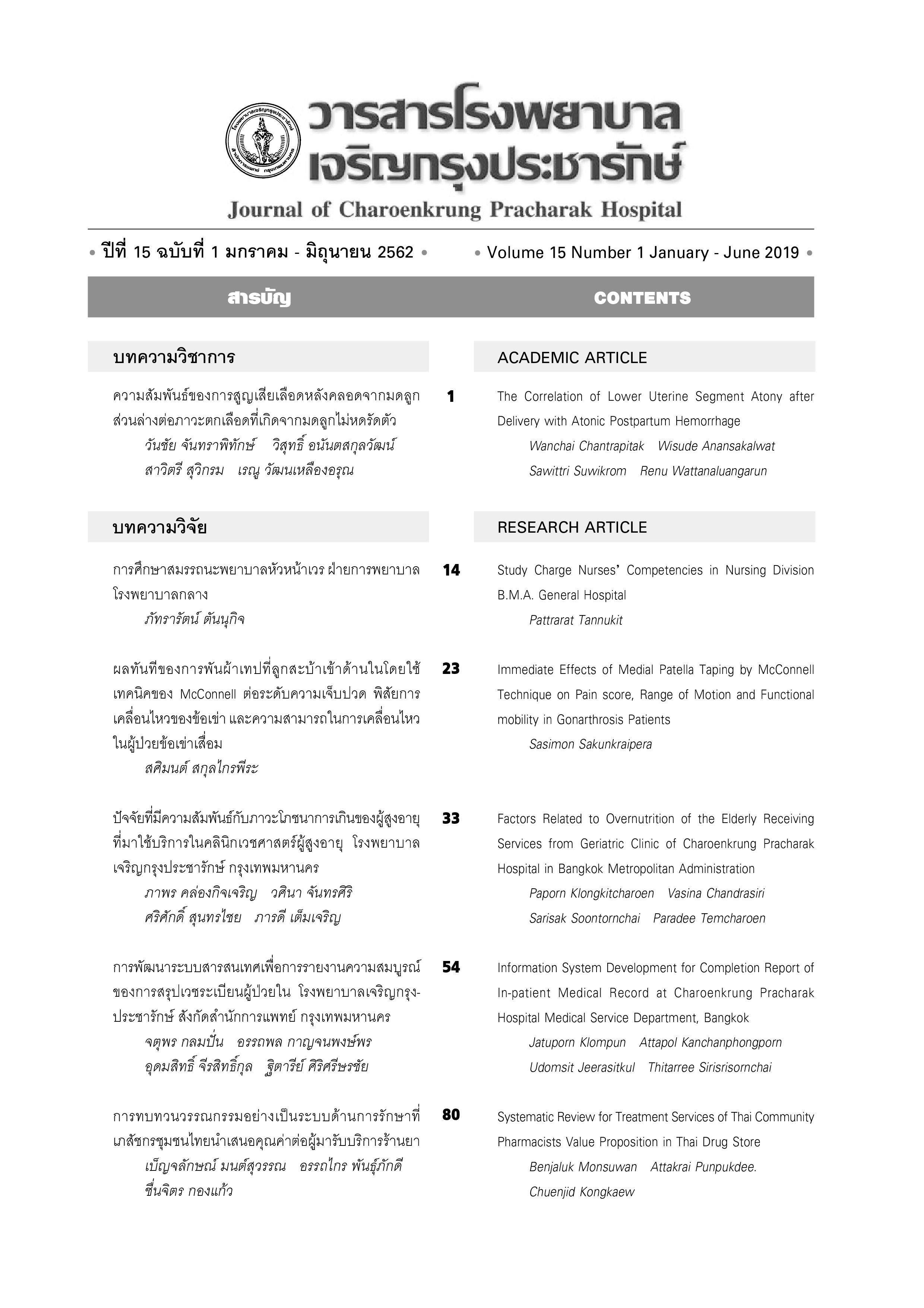ความสัมพันธ์ของการสูญเสียเลือดหลังคลอดจากมดลูกส่วนล่างต่อภาวะตกเลือดที่เกิดจากมดลูกไม่หดรัดตัว
Main Article Content
บทคัดย่อ
บทนำ: Postpartum Haemorrhage เป็นสาเหตุหลักที่ทำให้มารดาเสียชีวิตหลังคลอด และยังเป็นปัญหาจนถึงทุกวันนี้ ภาพรวมในปัจจุบัน PPH ได้ลดลงบ้างอย่างช้า ๆ แต่ในทางกลับกัน atonic PPH กลับเพิ่มขึ้นอย่างต่อเนื่องในระยะ 10 - 20 ปีมานี้ ในหลาย ๆประเทศที่พัฒนาแล้วทั้ง อเมริกา ออสเตรเลีย อังกฤษ แคนาดา เป็นต้น โดยที่ยังไม่มีใครทราบสาเหตุหรือปัจจัยเสี่ยงที่แท้จริงของ atonic PPH นี้ ปัจจุบันพบว่า lower uterine segment atony (LUSA) เป็นสาเหตุหนึ่งของ PPH ซึ่งอาจมีบทบาท เป็นสาเหตุนำในการเกิด atonic PPH ได้
วัตถุประสงค์: เพื่อวิเคราะห์ความสัมพันธ์ของ lower uterine segment atony ต่อภาวะ atonic PPH และประสิทธิผลของ lower uterine segment compression (LUSC) ต่อ lower uterine segment atony และ atonic PPH
วิธีการดำเนินการศึกษา: การศึกษานี้ได้ทบทวนวรรณกรรมที่ใช้หัตถการ lower uterine segment compression (LUSC) เพื่อป้องกันและ รักษา PPH ได้ผลดี ซึ่ง LUSC เป็นการรักษา lower uterine segment bleeding/atony โดยตรง โดยศึกษาผลลัพธ์ด้านอัตราการตกเลือด จำนวนเลือดที่สูญเสียหลังคลอด และภาวะแทรกซ้อนต่าง ๆ จากการศึกษาพบว่า กลุ่มผู้ป่วยที่ได้รับ LUSC มีอัตราตกเลือดหลังคลอดและภาวะแทรกซ้อนน้อยกว่ากลุ่มที่ไม่ใช้ LUSC อย่างมีนัยสำคัญ
สรุป: lower uterine segment atony เป็นสาเหตุของ atonic PPH โดยผ่านกระบวนการ continuous excessive bleeding จากมดลูกส่วนล่างที่หดรัดตัวไม่ดี (LUSA) จนเกิด uterine hypoperfusion และเกิด uterine hypoxia ตามมา uterine hypoxia เป็นสาเหตุหลักที่ทำให้มดลูกคลายตัวและไม่แข็งตัวแม้ให้ uterotonics แล้วก็ตามจึงเกิด uterine atony และเกิด PPH ในท้ายที่สุด
Article Details
เอกสารอ้างอิง
perspectives. Int J Womens Health. 2013 Nov 13; 5: 737-52.
2. World Health Organization. Making pregnancy safer. Reducing the global burden: postpartum
hemorrhage. Geneva: WHO; 2007.
3. WHO, UNICEF, UNFPA, the World Bank and the United Nations Population Division. Trends in
maternal mortality: 1990 to 2013. Geneva: WHO; 2014: 2-8.
4. WHO, UNICEF, UNFPA, the World Bank and the United Nations Population Division. Trends in
maternal mortality: 1990 to 2015. Geneva: WHO; 2015: 16-21.
5. World Health Organization. SDG3: Ensure healthy lives and promote wellbeing for all at all ages. Geneva:
WHO; 2015.
6. Azar M, Jennifer AH, Lily L, et al. Trends in postpartum hemorrhage from 2000 to 2009: a population-
based study. BMC Pregnancy & Childbirth 2012; 12: 108.
7. Joseph KS, et al. Investigation of an increase in postpartum haemorrhage in Canada. BJOG 2007:
114(6): 751-9.
8. Ford JB, et al. Increased postpartum hemorrhage rates in Australia. Int J Gynecol Obstet 2007: 98(3): 237-
43.
9. Kramer MS, et al. Risk factors for postpartum hemorrhage: can we explain the recent temporal increase? J
Obstet Gynaecol Can 2011: 33(8): 810-9.
10. Communication office. ACOG Expands Recommendation to Treat Postpartum Hemorrhage. The
American collage of obstetricians ans gynecologists. September 21, 2017.
11. A Weeks. The prevention and treatment of postpartum haemorrhage: what do we know, and where do we
go to next? BJOG. 2015 Jan; 122(2): 202-10.
12. World Health Organization. WHO Recommendations for the PPH prevention and treatment of postpartum
hemorrhage. Geneva: WHO; 2012.
13. Kramer MS, Berg C, Abenhaim H, et al. Incidence, risk factors, and temporal trends in severe postpartum
hemorrhage. Am J Obstet Gynecol. 2013 Nov; 209(5): 449. e1-7.
14. Marian K, William MC, Cynthia B, et al. Trends in postpartum hemorrhage in high resource countries: a
review and recommendations from the International Postpartum Hemorrhage Collaborative Group. BMC
Pregnancy and Childbirth 2009; 9: 55.
15. Wetta LA, et al. Risk Factor for uterine Atony/Postpartum Hemorrhage requiring treatment after vaginal
delivery. Am J obstet gynecol. 2013 Jul; 209(1): 51.e1-51.e6.
16. Committee on Practice Bulletins-Obstetrics. Postpartum Hemorrhage. ACOG Practice bulletin. No
183, Oct 2017.
17. Ramanathan G, Arulkumaran S. Postpartum hemorrhage. J Obstet Gynaecol Can 2006; 28: 967-73.
18. Bateman BT, Berman MF, Riley LE, Leffert LR. The epidemiology of postpartum hemorrhage in a large,
nationwide sample of deliveries. Anesth Analg. 2010; 1: 110.
19. Prata N, et al. Inability to predict postpartum hemorrhage: insights from Egyptian intervention data. BMC
Pregnancy Childbirth. 2011 Nov 28; 11:97. doi: 10.1186/1471-2393-11-97.
20. Warshak CR, et al. Accuracy of ultrasonography and magnetic resonance imaging in the diagnosis of
placenta accreta. Obstet Gynecol. 2006 Sep; 108(3 Pt 1): 573-81.
21. Yüksel H. A novel approach to primary lower uterine segment atony. Taiwan J Obstet Gynecol. 2015;
54(4): 452-4.
22. Laurence ES, Dena G, Aaron B.C, ACOG Practice Bulletin, Clinical Management Guidelines for
Obstetrician-Gynecologists, Obstet & Gynecol 2017; 130(4): 168-86.
23. Elagwany AMS, Dayem TMA. Primary lower uterine segment ballooning and atony as an unusual cause
of postpartum hemorrhage. Archives of perinatal medicine 22(1), 66-67, 2016.
24. Ekin A, Gezer C, Solmaz U, et al. Predictors of severity in primary postpartum hemorrhage. Send to Arch
Gynecol Obstet. 2015 Dec; 292(6): 1247-54.
25. Chantrapitak W, et al. Lower uterine segment compression for management of early postpartum
hemorrhage after vaginal delivery at Charoenkrung Pracharak Hospital. J Med Assoc Thai. 2009
May; 92(5): 600-5.
26. Chantrapitak W, Srijuntuek K, Wattanaluangarun R. The efficacy of lower uterine segment compression
for prevention of early postpartum hemorrhage after vaginal delivery. J Med Assoc Thai. 2011
Jun; 94(6): 649-56.
27. Anansakunwat W, Iamurairat W, Boonyoung P. Lower Uterine Segment Compression for 20 Minutes to
Prevent Early Postpartum Hemorrhage. J Med Assoc Thai 2018; 101 (9): 1151-6.
28. Chantrapitak, W, et al. Postpartum Hemorrhage Outcome in Lower Uterine Segment Compression
Maneuver: A 20-Year Experience in Charoenkrung Pracharak Hospital. J Med Assoc Thai 2018; 101 (4): 495-
500.
29. Earley L, Wray S. Effects of hypoxia on force produced by agonists and depolarization and arising
spontaneously in the rat uterus. J Reprod Fertil. 1993; 99 (2): 539-44.
30. Taggart MJ, Wray S. Hypoxia and smooth muscle function: key regulatory events during metabolic stress.
J Physiol. 1998 1; 509 (Pt 2): 315-25.


